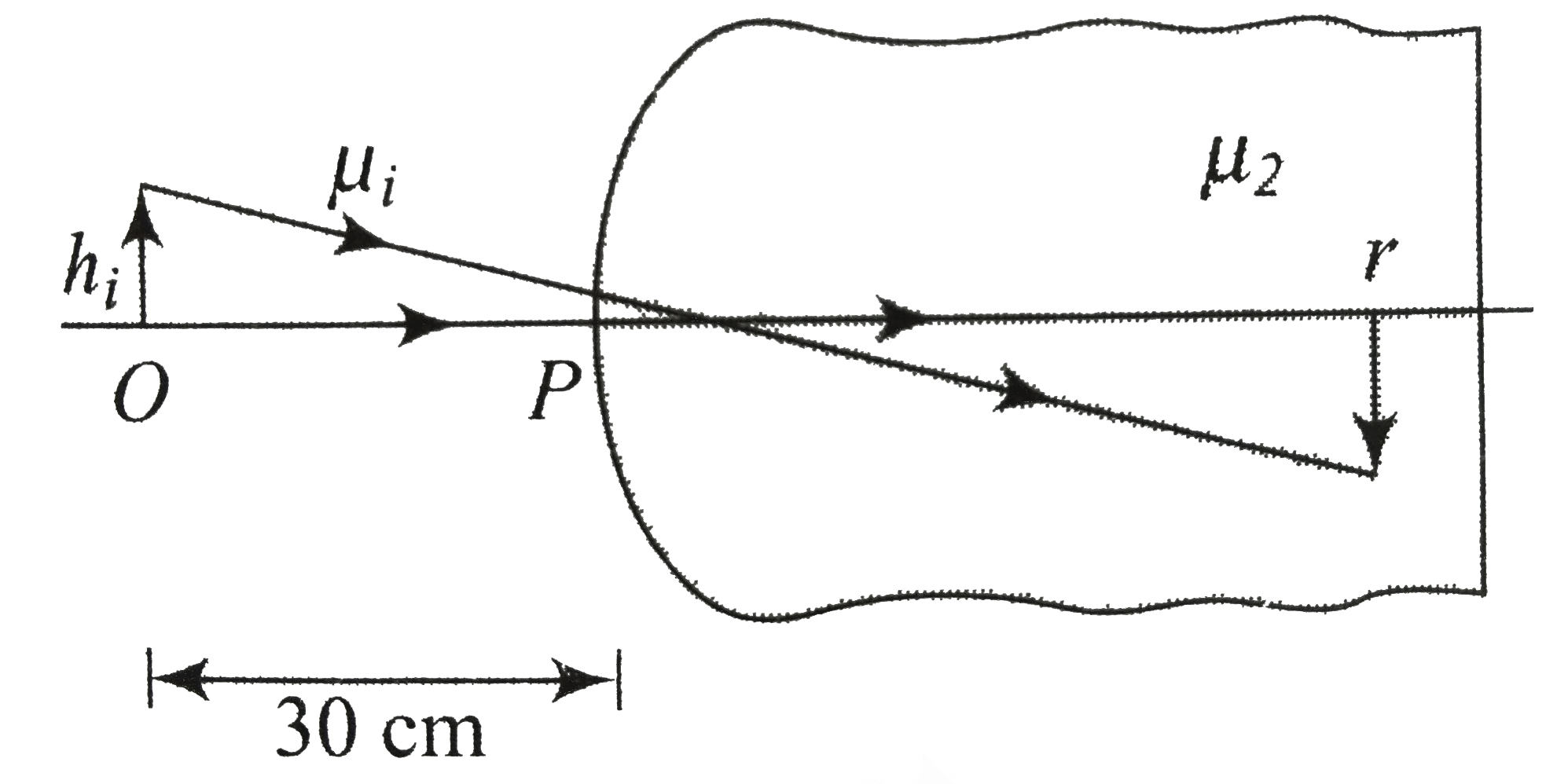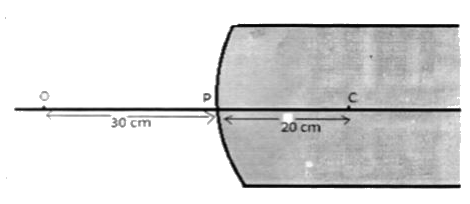An object is placed in front of convex surface of a glass piano-convex lens of thickness d = 9.0 cm. The image of that object is formed on the plane surface of the lens serving as a screen. Find: a the transverse magnification if the curvature radius of the lenss convex surface is R = 2.5 cm; b the image illuminance if the luminance of the object is L = 7700 cd/m2 and the entrance aperture diameter of the lens is D = 5.0 mm; losses of light are negligible.
a The formation of the image of a source S placed at a distance u from the pole of the convex surface of plane-convex lens of thickness d is shown in the figure.On applying the formula for refraction through spherical surface we getBut in this case optical path of the light corresponding to the distance v in the medium is v/n so the magnification produced will be Substituting the values we get magnification β = - 0-20. b If the transverse area of the object is A assumed small the area of the image is β2 A. We shall assume that Then light falling on the Jens is: from the definition of luminance See Eqn. 5.1c of the book; here
Related Solutions
An object is placed in front of convex surface of a glass plano-convex lens of thickness d = 9.0 cm . The image of that object is formed on the plane surface of the lens serving as a screen. Find: (a) the transverse magnification if the curvature radius of the lens's convex surface is R = 2.5 cm , (b) the image illuminance if the luminance of the object i s L = 7700 cd//m^(2) and the entrance apertune diameter of the lens is D = 5.0 mm , losses of light are negligible.
View SolutionThere is a plano-convex lens whose radius of curvature for convex surface is 2.5 cm. Thickness of the lens is 9 cm. When object is placed at a certain distance from the convex surface then image is formed on the plane surface of the lens which serves as screen. What should be the magnification in this case? Refractive index is 1.5.
View Solutionएक उत्तल लेंस के प्रत्येक पृष्ठ की वक्रता त्रिज्या 15 सेमी है। उसके सामने 15 सेमी की दूरी पर वस्तु रखी जाती है उसके प्रतिबिंब की स्थिति ज्ञात कीजिए।
View SolutionA spherical convex surface of radius of curvature 20 cm, made of glass (mu=1.5) is placed in air. Find the positon of the image formed, if a point object is placed at 30 cm in front of the convex surface on the principal axis.
View SolutionA small object of height cm is placed in front of a convex surface of glass of radius of curvature 10cm. Find the height of the image formed in glass.

View SolutionA small object of height 0.5 cm is placed in front of a convex surface of glass (mu-1.5) of radius of curvature 10cm. Find the height of the image formed in glass.
View SolutionA luminous point object is placed at a distance of 20 cm, from the pole of a convex spherical surface of glass. The radius of the curvature of the convex surface is 25 cm and the R.I. of the glass is 1.5. What is the distance of the image from its pole ?
View SolutionA spherical convex surface of radıus of curvature 20 cm, made of glass is placed in air Find the posıtion of the image formed, if a point object is placed at 30 cm in front of the convex surface on the principal axis.

View SolutionAn object is placed 30 cm in front of a plano-convex lens with its spherical surface of radius of curvature 20 cm. If the refractive index of the material of the lens is 1.5, find the position and nature of the image formed.
View Solutionएक वस्तु उत्तल लेन्स के सामने 2f पर रखी है, तो लेन्स से उसका प्रतिबिम्ब बनेगा-
View SolutionFocal length of the plano-convex lens is 15 cm. A small object is placed at A as shown in the figure. The plane surface is silvered. The image will for at
View SolutionA thin converging lens is formed with one surface convex and the other plane. Does the position of image depend on whether the convex surface or the plane surface faces the object ?
View SolutionA thin converging lens is formed with one surface convex and the other plane. Does the position of image depend on whether the convex surface or the plane surface faces the object ?
View SolutionA thin converging lens is formed with one surface convex and the other plane. Does the position of image depend on whether the convex surface or the plane surface faces the object ?
View SolutionA convex lens and a convex mirror are separated by a distance of 10 cm such that the reflecting surface of the mirror faces the lens. The image of an object placed in front of the convex. Lens at a distance of 20 cm is found to coincide with the object. If the focal length of the convex lens is 15 cm, determine the focal length of the mierror.
View SolutionA convex surface of radiys of curvature 20 cm separates air from glass of refractive index 1.5. Find the position and the nature of the image of a small object placed at 50 cm in front of the convex surface.
View SolutionA plano-convex lens P and a concavo-convex lens Q are in contact as shown in figure. The refractive index o fthe material of the lens P and Q is respectively. The radius of curvature of the concave surface of the lens Q is double the radius of curvature of the convex surface. The convex surface of Q is silvered.

An object is placed on the placed on the principal axis at a distance form the plane surface. The image is formed at a distance from the plane surfaces on the same side. The focal length of the system is
View SolutionA plano-convex lens P and a concavo-convex lens Q are in contact as shown in figure. The refractive index o fthe material of the lens P and Q is respectively. The radius of curvature of the concave surface of the lens Q is double the radius of curvature of the convex surface. The convex surface of Q is silvered.

An object is placed on the placed on the principal axis at a distance form the plane surface. The image is formed at a distance from the plane surfaces on the same side. The focal length of the system is
View Solution10 cm. In front of a convex mirror of radius of curvature 15 cm. The object is placed at a distance of , the magnification of the image will be
View SolutionThe radius of curvature of convex surface of a piano convex is.15 cm and refractive index of the lens is 1.6. The power of the lens is—
View Solution